Infrastructure (Research Facilities) at ITS
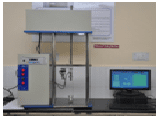
Universal Testing Machine
A universal testing machine (UTM), also known as a universal tester, materials testing machine or materials test frame, is used to test the tensile strength and compressive strength of materials. The "universal" part of the name reflects that it can perform many standard tensile and compression tests on materials, components, and structures (in other words, that it is versatile).
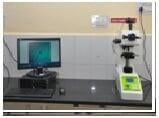
Vicker’s Hardness Machine
It is used to measure hardness value of a wide variety including metals, composites, and ceramics.The vickers has one of the widest scales among hardness tests. The unit of hardness given by the test is known as the Vickers Pyramid Number (HV) or Diamond Pyramid Hardness (DPH)..
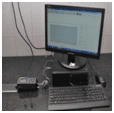
Roughness Tester
This instrument measures the roughness of various materials like wire, composites, metals, ceramics etc. When measuring the roughness of a surface, the sensor is placed on the surface and then uniformly slides along the surface by driving the mechanism by the sharp built-in probe. This roughness causes displacement of the probe which results in change of inductive amount of induction coils so as to generate analogue signal, which is in proportion to the surface roughness at output end of p hase-sensitive rectifier. The exclusive DSP processes and calculates and then outputs the measurement results on LCD.

Spectrophotometer Reflectance
The reflectance spectrophotometry is a technique for non-invasive analysis in which illuminates the surface to be analyzed with a light of a known spectrum and recording the spectral response of the surface.The relationship between the intensity of light hitting the surface and that which it reflects is said percentage reflectance (R [%]). This, calculated for each wavelength in the visible, defines the spectral behavior of the surface under examination. It is observed that the spectral behavior is characteristic of the material and is thus suitable for the survey.
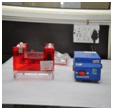
Agarose Gel Electrophoresis Unit
Agarose gel electrophoresis is a method of gel electrophoresis used in biochemistry, molecular biology, genetics, and clinical chemistry to separate a mixed population of DNA or proteins in a matrix of agarose. It applies the principle of Electrophoresis i.e the motion of dispersed particles relative to a fluid under the influence of a spatially uniform electric field.

Transilluminator
UV-transilluminators are used in molecular biology labs to view DNA (or RNA) that has been separated by electrophoresis through an agarose gel. During or immediately after electrophoresis, the agarose gel is stained with a fluorescent dye which binds to nucleic acid. Exposing the stained gel to a UVB light source causes the DNA/dye to fluoresce and become visible.
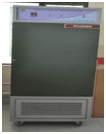
Incubator
A device used to grow and maintain microbiological cultures. The incubator maintains optimal temperature and humidity essential for lots of experimental work.
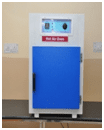
Hot Air Oven
Hot air ovens are electrical devices used in sterilization. The oven uses dry heat to sterilize articles. Generally, they can be operated from 50 to 300 °C (122 to 572 °F) . There is a thermostat controlling the temperature. These are digitally controlled to maintain the temperature. Their double walled insulation keeps the heat in and conserves energy, the inner layer being a poor conductor and outer layer being metallic.
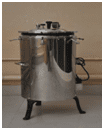
Refrigerated Centrifuge
Refrigerated laboratory centrifuges use an internal cooling system (compressor, condenser, etc.) to maintain the centrifuge chamber and hence the samples being centrifuges at a pre-set below ambient temperature.
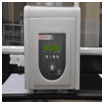
PH Meter
A pH meter is an electronic instrument used for measuring the pH (acidity or alkalinity) of a liquid (though special probes are sometimes used to measure the pH of semi-solid substances). A typical pH meter consists of a special measuring probe (a glass electrode) connected to an electronic meter that measures and displays the pH reading. The pH probe measures pH as the activity of the hydrogen cations surrounding a thin-walled glass bulb at its tip. The probe produces a small voltage (about 0.06 volt per pH unit) that is measured and displayed as pH units by the meter. For more information about pH probes, see glass electrode.
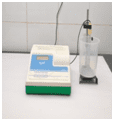
Digital Colony Counter
A device used for counting colonies of bacteria growing in a culture. It usually consists of an illuminated, transparent plate divided into sections of known area. Petri dishes containing colonies of bacteria are placed over the plate, and the colonies are counted according to the number within the areas viewed.

It is a micro well plate reader for quantitative, qualitative and semi-quantitative determination of wide range of analysts in body fluids. It consists of a light source that illuminates the sample using a specific wavelength (selected by an optical filter), and a light detector located on the other side of the well measures how much of the initial (100%) light is transmitted through the sample: the amount of transmitted light will typically be related to the concentration of the molecule of interest
